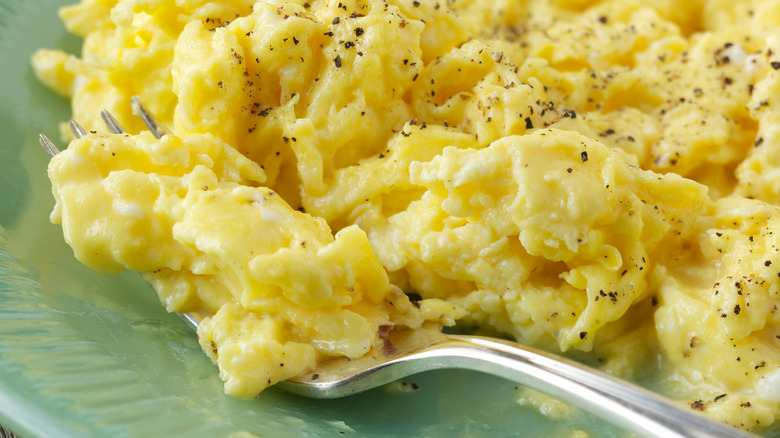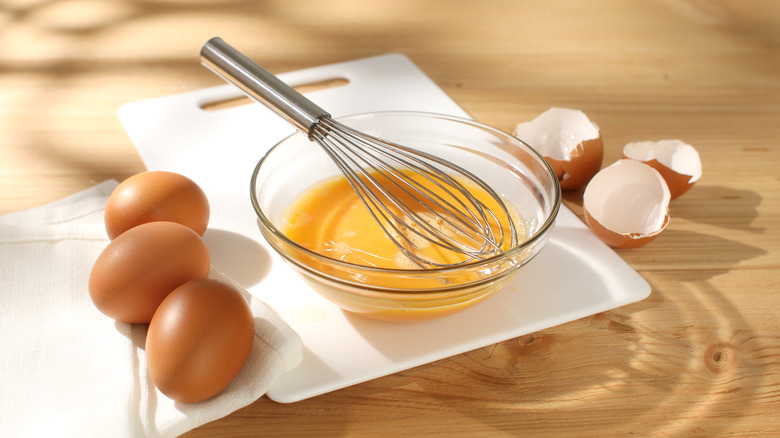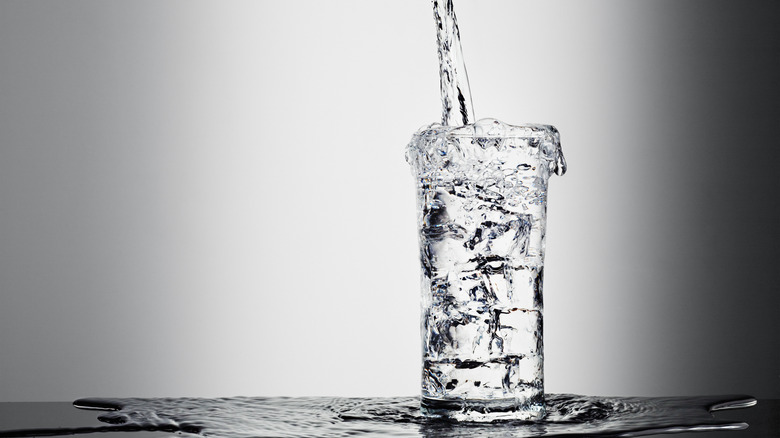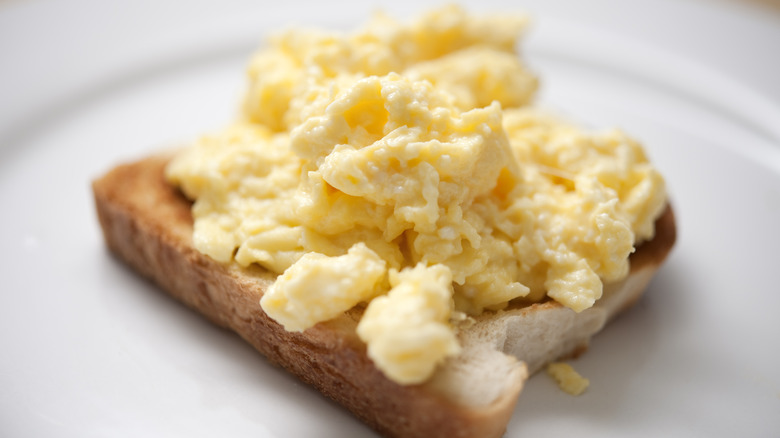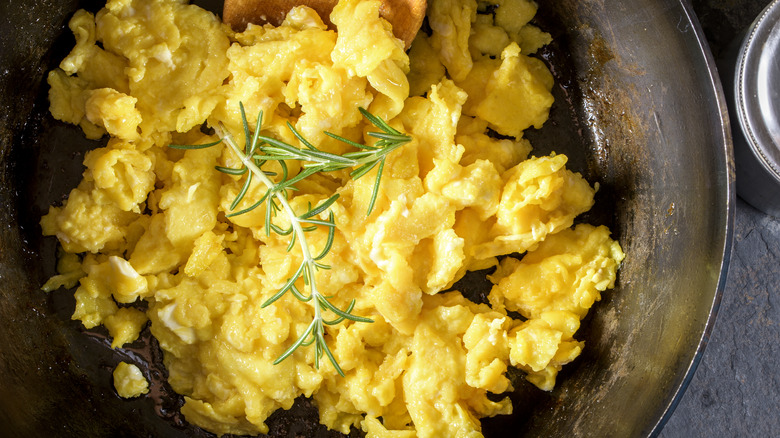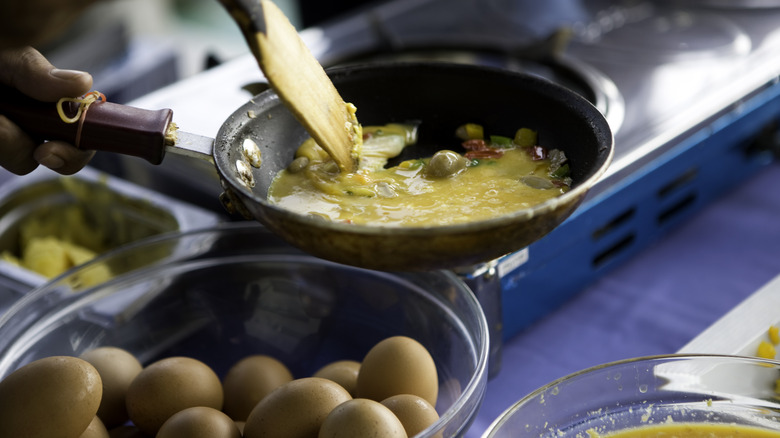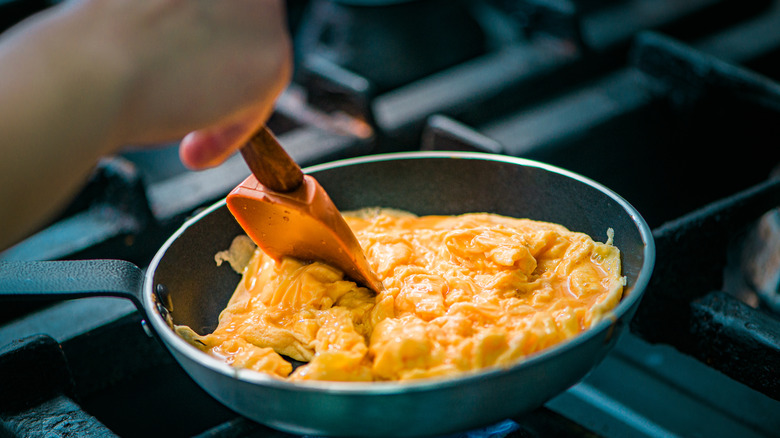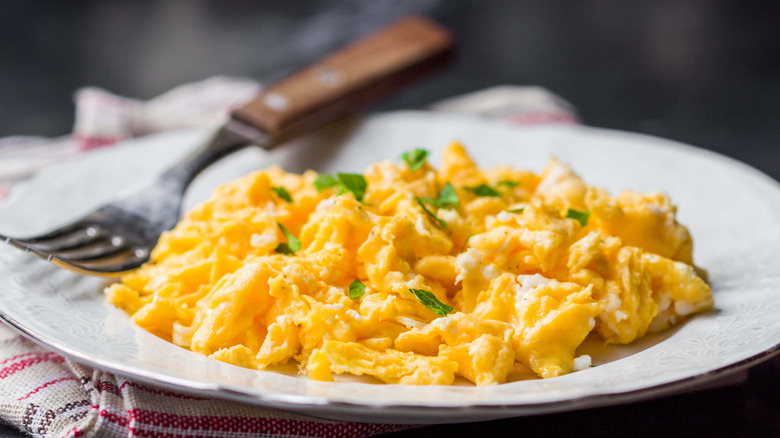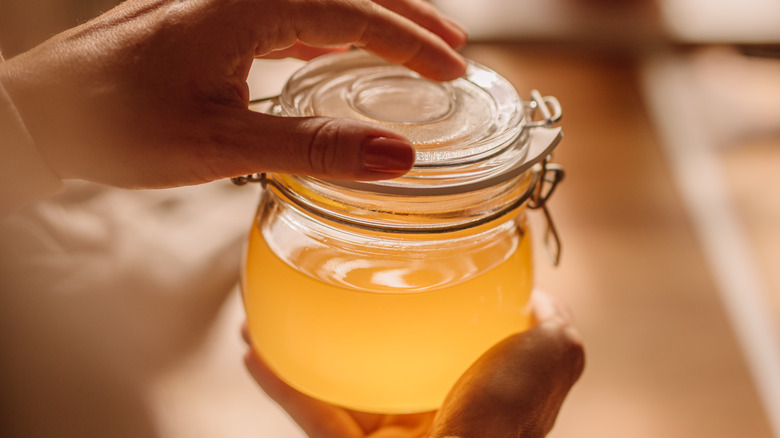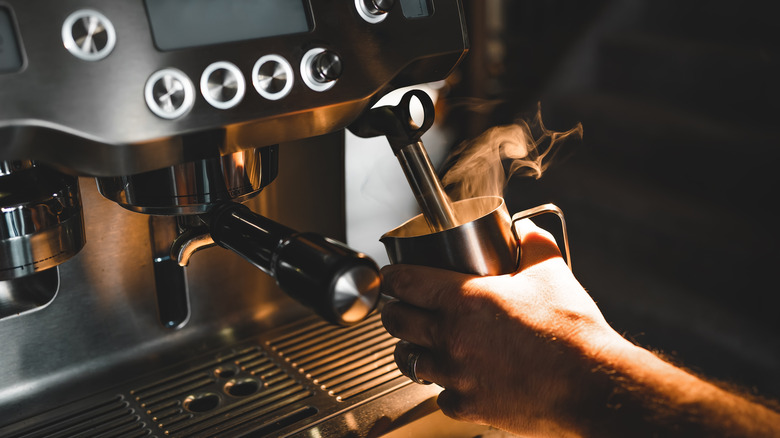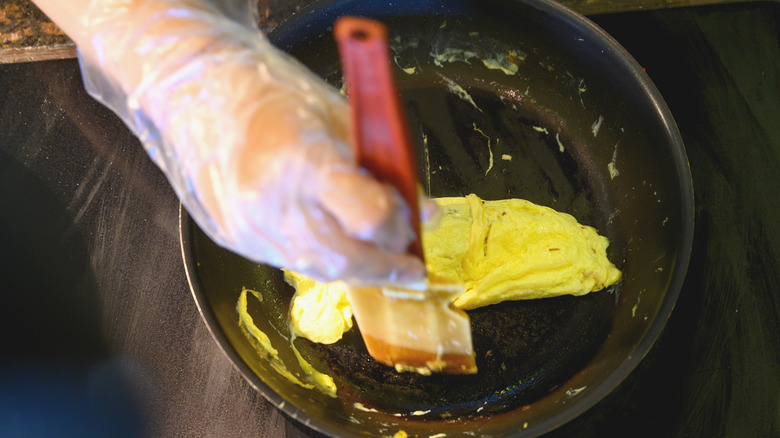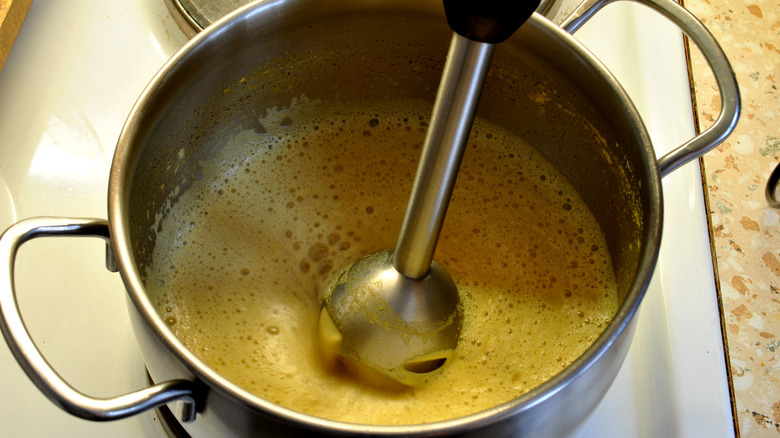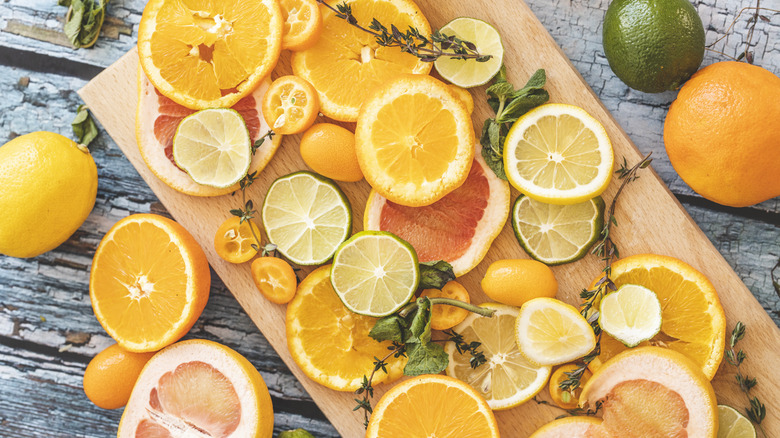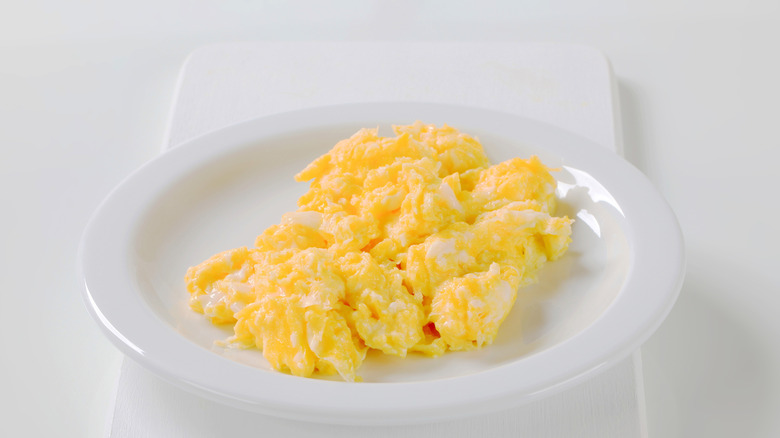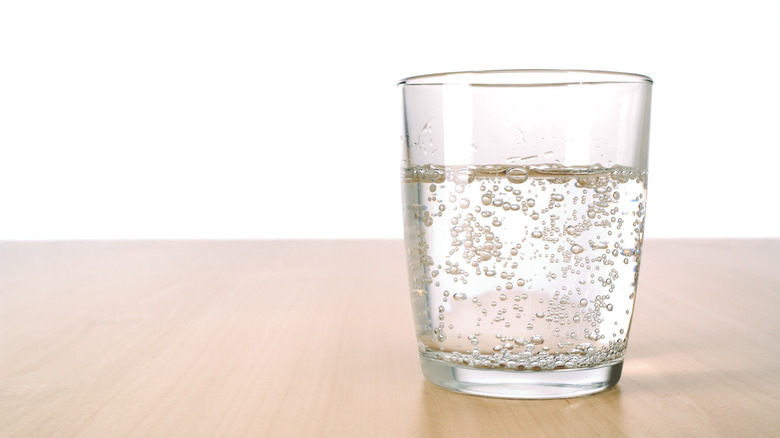For The Fluffiest Scrambled Eggs You've Ever Tasted, Try These Tricks
We may receive a commission on purchases made from links.
Scrambled eggs are the pinnacle of breakfast foods. A 2023 survey conducted by Mashed found that 45% of the 17,000 people surveyed preferred scrambled eggs over options like poached, hard-boiled, or fried, among others. When done right, scrambled eggs are soft, fluffy, and perfect for the most important meal of the day.
Unfortunately, scrambled eggs are also easy to mess up. When overcooked, the eggs get brown on the bottom and dry up. When too much liquid is added, the eggs can be runny and soupy, rather than thick and fluffy to coat your stomach and tide you over for the rest of the day. Now, with a myriad of different appliances, social media food hacks, and potential supplemental ingredients, experimenting with making the fluffiest scrambled eggs is easy. But just as the saying goes with too many cooks in the kitchen, too many tips up your sleeve may be hard to manage. Instead, let's consider some of the top tips for preparing a perfect plate of scrambled eggs — fluffy, well-seasoned, and delicious.
Utilize Gordon Ramsay's method of reducing heat
The heat is always turned up in the kitchen, both literally and figuratively, because the thought of overcooking eggs can be nerve-wrecking. Chef Gordon Ramsay's method for cooking scrambled eggs will alleviate some of the heat — because you have to take the eggs of the stove every thirty seconds.
Per Gordon Ramsay Restaurants, the chef's pan starts on high heat, and then Ramsay uses a 30 seconds on, 10 seconds off method, all while continuously stirring with a rubber spatula — not a whisk. The rubber spatula helps scrape the bottom of the pan without messing up the surface if you're working with a nonstick pan.
Ramsay also puts a wrench in the typical scrambled egg technique by cracking the eggs straight into a pan, rather than scrambling them in a separate bowl first. This is why stirring becomes so essential in this method; once the pan hits the heat, you have to blend together the eggs and all the butter you've added. Just before serving, Ramsay adds a teaspoon of crème fraîche, which helps lighten the texture and keep the eggs from overcooking. With this method, you'll get fluffy, soft scrambled eggs that will make your breakfast worth waking up for.
Add a splash of water
Perhaps the simplest way to fluff up your scrambled eggs is by adding a splash of water to your eggs. Often, recipes suggest adding milk or some sort of cream to your eggs, but if you want to keep this recipe to minimal ingredients, adding water gives the eggs an opportunity to steam in the pan. Water traps the moisture into the scrambled egg mixture, ensuring that your eggs turn out pillowy-soft by the end of the cook.
It is widely recommended to use one teaspoon of water per egg you're scrambling. Adding more than that may dilute your egg mixture and drown out any flavor, and adding too little won't make much of a difference at all. One teaspoon per egg is the perfect middle ground for making eggs that are fluffy and not dried out. Note that there's a difference between fluffy and creamy — if you're going for fluffy, this amount of water will do you better than adding the same amount of milk would. You should add the water into the scrambled egg mixture before pouring the mixture into the pan.
Use liquid moderately
Has Ina Garten ever steered us wrong? The answer is no, and she isn't going to start now. Perhaps the most important tip Garten has when making scrambled eggs is to avoid having a mixture that is too runny. So often, recipes tell us to add milk or half-and-half to an egg mixture, but adding too much can actually mute the flavors of the eggs and make them more difficult to make delicious.
You can actually see the liquid ooze out of the eggs when you've added too much, and it seems like the solution would be to cook them a little bit longer, giving the eggs time to absorb the moisture. That slippery slope leads to overcooked, grey eggs. The best way to avoid this is to just use less liquid to begin with.
In a recipe shared on Food Network's YouTube channel, Garten shows off how to limit liquid while batch-baking 16 scrambled eggs. She adds just half a cup of half-and-half, which comes down to about 1½ teaspoons per egg. Garten cooks her eggs using the low and slow method, stirring with a wooden spoon all the while. Once her eggs are just about finished, she lowers the heat even more, and to make them creamy, adds goat cheese to taste, and melts butter into it. The consistency of Garten's eggs is slightly runny but mostly creamy, and there's an unmistakable fluffiness that comes through even over video.
Cook them low and slow
The low and slow scrambled egg cooking method is tried and tested by many a home cook, and works especially well when using something like duck eggs. You can cook your eggs in rendered pork fat, which you can get from frying bacon, or just adding olive oil or butter to a pan. The low and slow method is not for the impatient at heart — it can take around 20 minutes for the eggs to cook, so this technique is only good if you have a bit of time before you have to head out for your morning stroll.
While eggs are on low heat, maintaining a consistent stirring motion helps keep the eggs from overcooking. The best way to do this is to scrape the sides and push the eggs into the middle of the pan, where most of the heat is harbored. This method should give your eggs a custard-like consistency.
You can tell when your pan might be getting too hot when it becomes a bit too difficult to scrape the eggs toward the middle — this is when you can invoke Ramsay's method, and remove the pan from the heat for a few seconds to give the eggs time to rest. The finished product will be a pile of eggs that are velvety smooth but not oozing liquid — a perfect balance for a perfect start to the day.
Follow Bobby Flay's technique
Food Network phenomenon Bobby Flay takes one extra step while making scrambled eggs that makes all the difference in creating a consistent, fluffy texture. The tip was first published in his cookbook, "Bobby at Home: Fearless Flavors from my Kitchen." After whisking the eggs in a bowl, Flay strains the eggs through a mesh strainer. The sifting helps to break apart any of the egg whites or yolks that might not have whisked together properly, bringing them together in the next bowl, keeping your egg mixture consistent.
Straining your eggs can also help prevent any mishaps in your egg mixture; namely, the strainer will catch stray pieces of eggshell that might have slipped through your fingers, and it will remove any bubbles to keep the mixture smooth. This method is also a practiced way to make smooth omelettes, and was so popular that you might recognize the move from "The Bear," season 2. So, if you want restaurant-quality scrambled eggs that are rich and fluffy, trying Bobby Flay's technique might be the right call.
Remove the eggs from the heat before they're done
This might seem contrary to the concept of cooking, but one really easy way to get your scrambled eggs fluffy is to take them off the heat before they're fully cooked. Eggs will continue to cook on the hot pan for as long as you leave them in the pan before serving, so you don't have to worry about eating undercooked eggs.
You should take the eggs off the heat when they're about 90% done, and the residual heat from the pan will do the rest of the work to cook them to perfect temp. As a comparison, if you were to cook the eggs all the way through and then leave them in the pan for thirty seconds longer — say, while you're grabbing a plate to serve them — the eggs would end up overcooking and getting slightly rubbery, which is sure to ruin your breakfast. This method is similar to Gordon Ramsay's on-and-off-the-heat method, the difference being that the "off" part of the method occurs here all the way at the end of the cook, rather than during.
Serve the eggs on a preheated plate
Now, this method might seem a bit extra, if you will, but in the same way you'd like to exit the shower and throw on a heated towel. As Alton Brown told Food Network, plating your eggs on a heated plate elevates the scrambled egg experience. Alton Brown — food connoisseur and host of shows like "Cutthroat Kitchen" and "Iron Chef" — favors this method.
This technique works similarly to not letting the eggs come to a full cook in the pan. Take the eggs off when they're 90% done, or with about a minute left to go, and serve them on a dish that has been warmed, maybe in the oven or the microwave. Like sitting in the pan, the eggs will cook in the residual heat and come to the perfect consistency just in time for you to start eating.
If you serve the eggs on a cold (or cabinet-temperature) plate, the eggs will begin cooling down as soon as you distribute them. This means when you sit down for your first bite, your eggs might be rubbery and cold, rather than the warm and fluffy scramble we're going for.
Switch to clarified butter
Martha Stewart has been known to present some reliable scrambled egg techniques. According to Food & Wine, at the 2021 Food & Wine Aspen Classic in Aspen, Stewart demonstrated her most recent method of making scrambled eggs perfectly: using clarified butter. Clarified butter is a type of butter that removes excess water and milk. The butter becomes more concentrated and rich in this way, so using it to make your eggs is a great way to create rich scrambled eggs that will taste good every time.
While you can purchase clarified butter at your local grocery store, Stewart goes the extra mile, of course, by making her own clarified butter. You can do this by melting regular butter down, and once those white, foamy solids rise to the top of the liquid, you just scoop them off with a spoon. The resulting liquid is your pure clarified butter, and you can pour a bit into the pan and heat it before pouring in your scrambled egg mixture. The resulting eggs have a golden color and a rich texture that makes switching out your butter worth it every morning.
Put your cappuccino machine to use
If you thought a cappuccino machine wasn't worth buying, you might change your mind after realizing just how versatile it can be. Besides making your morning cup of coffee, Martha Stewart surprised everyone by teaching how a cappuccino machine can actually be useful in making scrambled eggs.
This method utilizes the steamer of the cappuccino machine. Stewart whisks her eggs together in a mug, and then holds the mug underneath the milk steamer. Now, don't think that just because we're not using a pan, we're nixing the butter from this recipe — quite the opposite. Stewart adds the butter into the egg mixture before steaming the eggs, aiming to keep the rich creaminess that butter adds to the egg consistency.
Pull the eggs off the steamer and, with one quick mix using a fork, you're left with a pile of fluffy scrambled eggs that are perfect for topping toast, or just eating on their own. The goal is reached! Plus, the butter adds a welcome saltiness and creaminess that keeps the eggs from tasting rubbery from direct contact with the steamer.
Scramble with a rubber spatula
Just like there are so many appliances to use in the kitchen, there are just as many kitchen utensils, so it can be hard to know what the best one is for scrambling eggs. Should you use a fork, and risk scratching your nonstick pans? Would a whisk be as effective once the eggs start to solidify? Rubber spatulas are the be-all-end-all utensil for all things scrambled eggs.
Using a rubber spatula to cook your eggs makes it easy to push the eggs off the side of the pan and into middle, as well as to get any stuck bits off of the bottom of the pan. The rubber spatula is also great for folding the eggs, which is a great technique to form the fluffy mound that you look forward to eating.
In general, rubber spatulas are great for cooking with a high heat, and convenient, too, because for most, the spatula part comes off the wooden handle, so you're able to quickly wash the spatula in between uses. Plus, they come in a myriad of sizes, so they have a perfect versatility whether you're making two eggs or 10.
Whisk the eggs with an immersion blender
This is a fun one, because immersion blenders can be a fun tool to use in the kitchen. It is one of the most adaptable kitchen tools out there, used for making purees, dressings, or — in our case — making the smoothest scrambled egg mixture you've ever seen.
The reason an immersion blender works so well for scrambling eggs prior to cooking them is because the yolks and whites will be better combined when the immersion blender is used. The egg mixture is a key player in cooking fluffy scrambled eggs, and having a tool that will help fully scramble your eggs works wonders — especially if you don't want to take the extra step of straining your mixture before the cook.
Combining your eggs with an immersion blender also adds some bubbles into the mix, aerating the eggs and guaranteeing a fluffiness in your final cooked product. And if you're worried that you won't get enough use out of the immersion blender to keep one handy, don't be — you can use it to blend ingredients for guacamole, pancake batter, whipped cream, and so much more.
Include a touch of acid
If you're the kind of home cook that keeps lemons or limes readily available in your kitchen, this method is perfect for you. Adding a splash of acid to your scrambled eggs will help make the best plate of eggs — both by giving the eggs a bit more flavor and by making them fluffier.
Because eggs are a source of protein, acid responds to the protein in the eggs by denaturing them, which means breaking them down and changing their structure. This means that the eggs will stay softer for longer. Acid also works to aerate the eggs slightly — just as the immersion blender does — keeping the eggs soft-scrambled and fluffy while you're cooking. Start slow, by adding a teaspoon of acid at a time to see how your taste buds adjust, and then add more as desired.
You can use lemon or lime juice as your acidic portion, or even add vinegar to your eggs instead. Or, if you want to sweeten the deal a bit more, you can add orange juice to your eggs. Using this citrus will give the same effect as the lemon or lime juice, but it would also add a touch of sweetness that you might welcome into your breakfast. You could even add the lemon, lime, or orange zest over the top of the eggs once you've plated them for a little extra spark of flavor.
Extra cream works wonders
Remember, you want to avoid making your scrambled egg mixture too liquidy, so in this case, extra cream doesn't mean heavy cream or milk. Instead, try adding crème fraîche or sour cream to your eggs to elevate them. Along with managing heat and straining your eggs, adding a cream is an egg technique used in the recipes of Gordon Ramsay and Bobby Flay.
Crème fraîche is a thicker version of sour cream, made of pasteurized milk and bacteria. The best way to add crème fraîche to your eggs is to add it when they're 80-90% cooked, and continue to scramble them, stirring the crème fraîche in all the while. The extra ingredient adds a creaminess to the eggs that makes them velvety soft, making breakfast a little bit more decadent.
Sour cream will have the same effect as crème fraîche with a little more flavor added to your eggs. Because sour cream has a tangy taste that is pleasantly sour, it will make your scrambled eggs more creamy while also adding in a more vibrant flavor that is sure to wake you up in the morning. Plus, both sour cream and crème fraîche have a ton of other uses, as you can use them to top tacos, to eat alongside fruit, or even to add some creaminess to your next cheesecake recipe.
Soda water helps develop more bubbles
In the same way that the added bubbles from the immersion blender work wonders for fluffy eggs, using soda water can have the same effect with way less effort. Soda water is just carbonated or sparkling water, also called club soda. The bubbles trapped in the carbonated water aerate into the eggs, creating pockets of air that react well to the heat while cooking. These pockets expand, making the cooked eggs taste lighter because they're more airy.
The best tips here are to use plain, non-flavored soda water, and to not use milk or cream in addition to the soda water. Sticking with just soda water will yield the best result. The eggs also cook a little bit faster when you use soda water, so be sure to keep an extra eye out so as not to overcook them. When they're done, you'll be left with a cloud-like plate of eggs that is melt-in-your-mouth delicious.
Static Media owns and operates The Takeout, Tasting Table, and Mashed.
